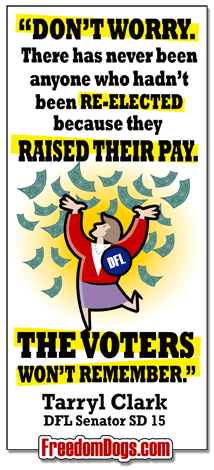Wednesday, February 22, 2006
Live blog: Andrew Zimbalist: Economics of sports stadia
At the time of Kelo, this is an interesting time to be studying sports stadia. A backlash has arisen, so that the FLA legislature has told the Florida Marlins are not geting a rebate of the sales tax they pay. At the same time, the Yankees and Mets are asking for public money to build new stadia, and the Twins can opt out of their lease at the Metrodome, Zygi Wilf, etc.
Fiscal situation in 2006 is more dire. There has been a movement from DC to decentralize, to put more responsibilities on state and local governments. Sales tax revenue is harder to come by. Higher interest rates are causing debt service costs to rise. So cities and states don't have as much to spend on teams and ballparks.
Coalitions form to make a "stadium drive". They hire consultants to do an economic impact stadia. The studies use faulty techniques -- input-output analysis -- that are giving wrong advice. Data are too aggregated, they use old coefficients that make no sense now. They neglect to differentiate between gross and net spending. Example: $1 billion to build Yankee stadium proposal, on the west side of Manhattan, to create 440 jobs, which comes out to more than $2 million per job.
All economists agree: You cannot expect that a new stadium will raise the level of economic development in your city. What is the basis of this conclusion?
- Although an immense presence, the team is a small enterprise economically. 75-100 work permanently, maybe another 200-300 part time jobs. Yankees contribute less than 1/20 of 1% of the economic value created by NYC.
- Substitution effect. What you spend at the ballpark isn't spent elsewhere; much of that money would have been spent elsewhere in the city (probably on entertainment.) Some dollars are new, but not that many, and even those people travelling from outside the area might travel here anyway.
- Leakages. Contrast dollar spent at restauarant and dollar spent at ballpark. 60% of the revenue generated by sports teams goes to players. Most players don't live in the cities they play in. Much of their money is spent elsewhere. And they save a great deal of the money. So too with owners. Local restauranteur lives in town, spends in town, hires local labor, etc. So constructing the ballpark might cause some money to leave the economy more than otherwise.
- Budgetary. The government has to put out more money to service the debt, for security around the ballpark, sanitation, infrastructure, operating costs and improvements to the park (depending on the lease). If you compare the outflows and inflows of money to the municipal budget, the net effect is usually negative. This inhibits the ability of the city to spend elsewhere, or it causes taxes to rise; each lowers the level of economic activity in the local economy. All of this depends on the lease terms. But the point is that stadiums are NOT free goods. Tourist taxes (hotels, rental cars) don't cover the costs. Tourists not only don't come for ballgames, they don't come for other things either. Conventions looking at where to go look at the higher taxes and hold that against the cities who raise them. If raising taxes wouldn't effect these decisions, why didn't the city raise those rates already? (Those are already set at revenue-maximizing rates.).
- Possibility of cost overruns. When plans are made, the first plan is for a barebones stadium. Cost is small, they get approval. Then they add bells and whistles. When the initial plans were to renovate Yankee Stadium, the cost was $23 million; it ended up $110 million. Milwaukee Brewers $230 million --> $400 million and climbing. The new Washington DC park, $535 million to now $670 million plus another $80 million to buy the land. Etc.
Things change when you have substantial private investment and a good deal of non-sports development with it (like the Wilf proposal.) Wilf says he will put $1 billion into a $1.5 billion project. His money is new. But even here you have to be aware that the local construction industry might already be fully employed. All Wilf does then is put a new project in the queue, which raises construction prices, generating local inflation.
What about the success stories (Cleveland, Denver) -- wasn't there a positive impact there? As a general proposition, Coors Field was built in an area that was going to develop anyway. It's growing fast anyway; what did Coors Field displace in private investment? Did the stadium create the development, or would it have happened naturally? Parking lots help capture fans to spend only on things that give the sports owner revenue. Cleveland had growth for awhile, but it's not as apparent now.
A more positive argument. Quality of life. Having a sports stadium creates something that brings local people together. Cheering for the home team creates a bond that isn't usually there in our individuated society. Following the local team creates a benefit even if they don't go to the game. And the fans at the park are getting quite a deal. Should the local government pay for these things? This is totally subjective. Some people don't get the benefit. The problem with this argument is that the sports leagues are monopolists. Scarcity is artificial; with fewer franchises you get cities competing with each other, offering higher and higher subsidies. The quality of life argument then leads to overpayment.
NFL team profits are huge. There's extensive revenue sharing. TV money is all national, all equally shared. Gate revenue shared 66/34 (including premium seats.) None of the luxury suites, catering, concession, naming and scoreboard revenues, etc. Only new stadiums generate this last part of the revenue, so it helps. NFL G3 program, loans to local owners which are actually grants. $50-$100 million by city size. This is part of Zygi's share. In baseball, 2/3-3/4 teams are profitable. Revenue sharing has started, based on net local revenue. Twins got $22 million from revenue sharing last year. If they paid $200 million towards a $500 million stadium, they get to take some of that and count it against its net local revenue and increase their take of revenue sharing money. probably about $90 million of the $200 million.
NFL salary cap, most teams about at it. So if you spend more money to help the team build a new stadium, it doesn't change how the team plays on the field. Without salary cap in baseball, new stadiums lead teams to spend more on payroll, and performance improves.
You hear threats of relocation or contraction. Very unlikely this will happen. NFL teams could be populated in many other places. The problem for Wilf is that the league would be mad that a large TV market would be abandoned. The NFL can use the G3 money as a stick to keep him in place. It can also charge a relocation fee. For baseball, no revenue sharing, but you need to fill the stadium 81 games a year, but none are in a position right now to build them a new stadium. DC bid against itself for the Expos. They've got no place viable to go to. Contraction requires a whole year's notice, and the industry is growing. Not likely to happen. Strong demand means that they want to grow. (Lights went out here, and Zimbalist jokes he's talked too long. Now back on.) Also the threat of losing the antitrust exemption.
Economics are clear, quality of life is an issue, but it gets used against them. Twins and Vikes have no good leverage, so local authorities should bargain hard for a good deal for local taxpayers.
My comments: One frequent comment I heard after this encyclopedic presentation was that Zimbalist saw some merit in the Vikings proposal insofar as it promises private money. Of course, sometimes these promises are broken, as it is probably impossible to get the Wilf money escrowed somewhere. It's not all his -- the private development around the Blaine proposal is to come from a variety of sources. But I do think his point is valid.
The other thing that struck us was his optimism that the Vikings really have no leverage here. I fully agree. Part of the mythology up here is that the Pohlads are greedy, that Red McCombs is greedy. Wilf has yet to be tarred with that brush, but I suspect at some point he will. Everyone acts on the leverage at their disposal. Another person who is from the San Antonio area laughed that Red sold Zygi a bill of goods -- it's worth remembering that the Blaine proposal existed prior to Zygi's purchase of the team and was developed in large part with Red's active participation. "Red's a car dealer, and he never leaves a dollar on the table," said this observer. I think as Zygi realizes that the NFL will make it difficult for him to move the Vikings, he will have the same problem Red had -- pressuring Minnesota voters and politicians who will react by calling a business owner greedy.
I had a blast driving Zimbalist to the airport after, the first time I have ever talked to him. He's a fan of the Red Sox like me, familiar with the team's operations, and we shared an interest in Eastern Europe as well. We went in our careers in opposite directions -- me from sports to comparative economics, him from comparative to sports. But we still have interests in both. Damned fun.
Categories: economics, sports









